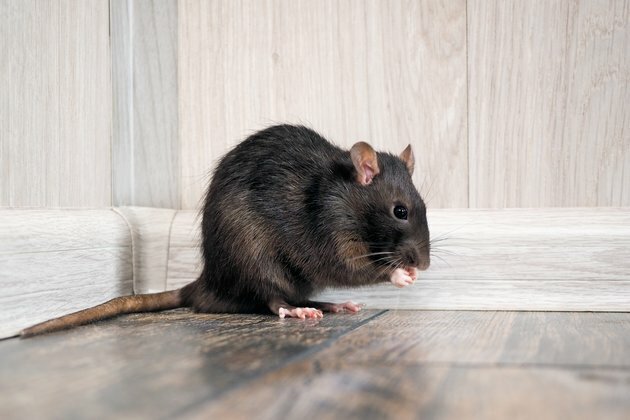Curious Kids: where did rats first come from?
The Conversation
13 Aug 2019, 11:48 GMT+10

If you have a question you'd like an expert to answer, send it to [email protected].
Rats are everywhere - at least everywhere that humans are. In almost every big city in the world, rats are eating our rubbish, breeding in our buildings, and running through our streets.
But there are lots of different types of rat. And where they originally came from depends on which rat species you are talking about (species means they're of the same animal type).
Read more: Curious Kids: Where did the first person come from?
Black rats and brown rats
There are two rat species that usually live in cities.
One is the black rat (what scientists would call Rattus rattus). They're sometimes called the "ship rat" because they've been spread around the world on ships. They're also known as the "roof rat" because they like to live in roofs. Rattus rattus is originally from India and began to live with humans more than 4,000 years ago, and slowly spread west into Europe about 3,000 years ago.
Then there's the brown rat (which scientists would call Rattus norvegicus). They are twice as big as black rats. They're the main city rat in Europe and America, but they live in Australia too. They're also known as the sewer rat (because they like to live in drains) or the Norway rat (because people mistakenly thought they came from Norway.)
Most pet rats and lab rats are brown rats. They originally came from China and spread around the world later than black rats. They probably arrived in Europe around the 1300s and spread worldwide in the late 1700s.
Black rats are the most common species in Australian cities but brown rats can be more common in older inner-city areas. There are a lot of brown rats in Brisbane, so chances are you have seen one.
Both black and brown rats came to Australia with Europeans on ships, which is how they spread to many other places in the world too.
Skeletons of black rats were found in the gun barrels of Dutch ships that sank off the west coast of Australia in 1616, but black rats probably entered Australia with the First Fleet in 1788.
Some Europeans thought at first these rats were a native Australian species, as they look quite similar to local rats and liked living in our native trees. But now we know they arrived with the Europeans.
Brown rats also probably arrived with the British but we don't know exactly when.
Cities are perfect for rats
City rats have three main secrets to their success.
First, they eat pretty much anything.
Second, they produce lots of babies, and fast. A female can have up to 12 pups in a litter, every month, and those babies can breed in just a few months.
And third, they're bold but smart and have worked out what's safe and what's dangerous in the city.
It's no wonder rats survive and thrive in the city.
Australian native rodents
Rats are a type of animal called a rodent. There are about 2,200 different species of rodents, including mice, squirrels, guinea pigs, beavers, and many more. Rodent-like mammals have been around for 66 million years, appearing soon after dinosaurs went extinct. They are now spread across the globe.
Australia has more than 60 species of native rodents that evolved here, and rodents make up a quarter of all our native mammal species.
Our largest is the water rat (Hydromys chrysogaster), which can weigh more than 1kg. That's more than four times the size of black rats! You still sometimes see them in cities like Sydney, Melbourne, and Perth.
The smallest is the delicate mouse (Pseudomys delicatulus), which weighs less than 10g and lives in Australia's central deserts.
Unfortunately, many of Australia's native rodents are threatened with extinction, mostly due to introduced predators like foxes and feral cats.
Read more: Curious Kids: how can penguins stay warm in the freezing cold waters of Antarctica?
Hello, curious kids! Have you got a question you'd like an expert to answer? Ask an adult to send your question to [email protected]
Author: Peter Banks - Professor of Conservation Biology, School of Life and Environmental Sciences, University of Sydney 
 Share
Share
 Tweet
Tweet
 Share
Share
 Flip
Flip
 Email
Email
Watch latest videos
Subscribe and Follow
Get a daily dose of Asia Pacific Star news through our daily email, its complimentary and keeps you fully up to date with world and business news as well.
News RELEASES
Publish news of your business, community or sports group, personnel appointments, major event and more by submitting a news release to Asia Pacific Star.
More InformationAsia
SectionThousands gather in Himalayas as Dalai Lama celebrates 90th birthday
DHARAMSHALA, India: The Dalai Lama turned 90 on July 6, celebrated by thousands of followers in the Himalayan town of Dharamshala,...
Beijing hits back at EU with medical device import curbs
HONG KONG: China has fired back at the European Union in an escalating trade dispute by imposing new restrictions on medical device...
Himachal CM extends best wishes to Indian players for Shitokai Goju-Ryu Karate Championship in Japan
Shimla (Himachal Pradesh) [India], July 12 (ANI): Himachal Pradesh Chief Minister Thakur Sukhvinder Singh Sukhu flagged off a 20-member...
Update: Chinese FM spokesperson's remarks on Philippines' statement on 9th Anniversary of "2016 Arbitral Award on the South China Sea"
BEIJING, July 12 (Xinhua) -- China's position on the 2016 Arbitral Award on the South China Sea is consistent and clear. The award...
MoS Margherita reaffirms 'enduring bonds of friendship' between India and Cambodia
Phnom Penh [Cambodia], July 12 (ANI): Union Minister of State for External Affairs Pabitra Margherita reaffirmed the 'strong and enduring...
Interview: Philippines burdened by South China Sea arbitration, says expert
The arbitration has in fact become an anchor around the Filipino people's neck, weighing the nation down economically, said Herman...
Business
SectionAI saves $500 million for Microsoft as layoffs reshape strategy
REDMOND, Washington: Artificial intelligence is transforming Microsoft's bottom line. The company saved over US$500 million last year...
FTC’s rule to ease subscription cancellations struck down by court
WASHINGTON, D.C.: A federal rule designed to make it easier for Americans to cancel subscriptions has been blocked by a U.S. appeals...
Musk’s X loses CEO Linda Yaccarino amid AI backlash, ad woes
BASTROP, Texas: In a surprising turn at Elon Musk's X platform, CEO Linda Yaccarino announced she is stepping down, just months after...
Ex-UK PM Sunak takes advisory role at Goldman Sachs
NEW YORK CITY, New York: Former British prime minister Rishi Sunak will return to Goldman Sachs in an advisory role, the Wall Street...
Gold ETF inflows hit 5-year high as tariffs drive safe-haven bets
LONDON, U.K.: Physically backed gold exchange-traded funds recorded their most significant semi-annual inflow since the first half...
PwC: Copper shortages may disrupt 32 percent of chip output by 2035
AMSTERDAM, Netherlands: Some 32 percent of global semiconductor production could face climate change-related copper supply disruptions...













